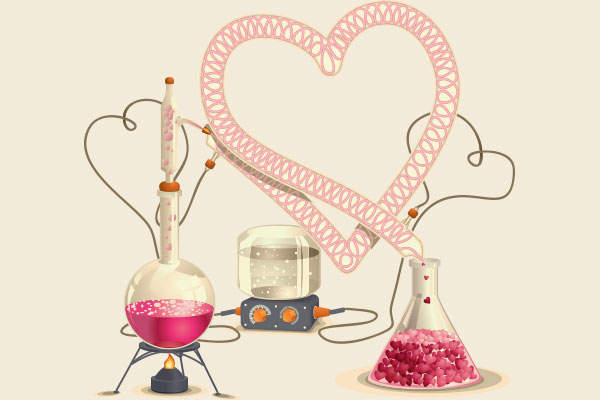
Share the Story on FacebookShare the Story on TwitterShare the Story via EmailShare the Story on LinkedIn
|
THAT'S THE WAY LOVE GOES
The 90s told us “men are from Mars, women are from Venus.” The 2000s said compatibility is as easy as logging online. And today, we just swipe right to find our match.
You would think the answer to finding chemistry with someone would be easy.
But love seems to trigger all sorts of questions about how to find it, how to keep it and how not to fall out of it.
So, are we hardwired to develop an attraction for others? Or is love about our own preconceived notions of what relationships should look like?
Professors at Clayton State say it’s a bit of both—our brains responding to our innate desire to bond with someone.
“Bonding between individuals seems to be a pretty big part of what our brains are good at,” says biology professor Dr. Stephen Burnett.
From birth, humans are meant to connect. Newborns experience their first social interactions when they latch onto their mother.
What makes this possible is oxytocin, a hormone that affects social behavior and sexual reproduction. It acts as a neurotransmitter—a chemical messenger that sends signals from our brain to other parts of our body to encourage bonding, aid in childbirth, and trigger lactation.
“[The mom] is getting this oxytocin that says this person I’m interacting with is someone I should be developing an attachment to,” Burnett says.

"Bonding between individuals seems to be a pretty big part of what our brains are good at," Burnett says.
Our brains also respond to pleasure and rewards. Hormones like dopamine and serotonin trigger our mood, appetite, and sexual desire.
It’s the reason why we sometimes feel anxious, happy or depressed. Alternatively, these hormones can spur addiction in some people.
“Especially when you’re first dating someone, and spending time with them, you can almost get addicted to it, it seems like,” he explains. “Those same hormones can be evolved in some kinds of addiction. So, they’re stimulating the same areas of the brain, but in this case, through the bonding you’re getting with this person.”
“We’re clearly evolved to do that sort of thing,” Burnett adds.
In fact, a group of Harvard professors in 2005 conducted a radical study at the time, analyzing the brain scans of 2,500 college students to compare their reactions to photos of people they were attracted to versus acquaintances.
The researchers found that when participants viewed photos of people they had romantic feelings for, parts of the brain loaded with high levels of dopamine were activated giving off those feel-good senses.
But love can’t be simply summed up by what happens between our ears.
How we define relationships, what makes someone a good partner, and even our notions about sex can be shaped by our environment and societal perceptions.
“The broad sense of the idea is that attraction is just evolutionarily our way to replicate ourselves, to put more humans on the earth,” says psychology professor Dr. J. Celeste Walley-Jean. “But the absoluteness of that has come under some scrutiny”
Instead, Walley-Jean says, our social cues can be born out of learned cultural and societal norms, typically falling across gender lines.
Whether that be men appearing as strong and dominant, or women being coy and not so assertive, individuals can exhibit attitudes commonly associated with their sex to attract others.
"No one can define attraction except the person themselves," Walley-Jean says. "It's what you are drawn to, what pulls you. That varies across individuals."
Yet, people can break from those traditional views in search of a partner that fits what they want in a relationship.
“Are there women out there who want a man because he’s sensitive and not because he has a lot of money? Absolutely,” she says. “But our gender norms constrain the woman’s ability to find that because that man would have to be going against gender norms, and that’s challenging to do.”
Even in homosexual relationships, Walley-Jean notes, the principles of attraction remain despite who the partners are.
“We have gendered the conversation around attraction. So, we say this is what men are looking for and what women are looking for,” she states. “Who the two partners are doesn’t change these dynamics, it just might change how they’re presented.”
On the whole, familiarity and closeness is more the norm when relationships develop.
“If I live next door, or we go to the same school, or we are in the same class—there’s a higher likelihood that we will be attracted to someone who’s near us. It’s called the proximity effect,” Walley-Jean says. “That’s why workplace affairs happen.”
And for much of the emphasis we put on human complexities to explain why people are attracted to each other, we’re no different than other animals when it comes to the birds and the bees.
“We evolve from animals that do these sorts of things, which shouldn’t come as a surprise that our brains work the same way as a mouse or a cat or a dog,” Burnett says. “A lot of the basic building blocks are there from other animals, and we just keep using them.”
So, what is attraction? It’s what you make of it.
“No one can define attraction except the person themselves,” Walley-Jean says. “It’s what you are drawn to, what pulls you. That varies across individuals.”
Read more stories from this issue
